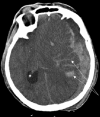Neuroimaging in traumatic brain imaging
- PMID: 15897957
- PMCID: PMC1064998
- DOI: 10.1602/neurorx.2.2.372
Neuroimaging in traumatic brain imaging
Abstract
Traumatic brain injury (TBI) is a common and potentially devastating clinical problem. Because prompt proper management of TBI sequelae can significantly alter the clinical course especially within 48 h of the injury, neuroimaging techniques have become an important part of the diagnostic work up of such patients. In the acute setting, these imaging studies can determine the presence and extent of injury and guide surgical planning and minimally invasive interventions. Neuroimaging also can be important in the chronic therapy of TBI, identifying chronic sequelae, determining prognosis, and guiding rehabilitation.
Figures









Similar articles
-
Imaging assessment of traumatic brain injury.Postgrad Med J. 2016 Jan;92(1083):41-50. doi: 10.1136/postgradmedj-2014-133211. Epub 2015 Nov 30. Postgrad Med J. 2016. PMID: 26621823 Review.
-
Recent neuroimaging techniques in mild traumatic brain injury.J Neuropsychiatry Clin Neurosci. 2007 Winter;19(1):5-20. doi: 10.1176/jnp.2007.19.1.5. J Neuropsychiatry Clin Neurosci. 2007. PMID: 17308222 Review.
-
Quantitative magnetic resonance imaging in traumatic brain injury.J Head Trauma Rehabil. 2001 Apr;16(2):117-34. doi: 10.1097/00001199-200104000-00003. J Head Trauma Rehabil. 2001. PMID: 11275574 Review.
-
Perfusion Imaging in Acute Traumatic Brain Injury.Neuroimaging Clin N Am. 2018 Feb;28(1):55-65. doi: 10.1016/j.nic.2017.09.002. Epub 2017 Oct 23. Neuroimaging Clin N Am. 2018. PMID: 29157853 Free PMC article. Review.
-
Imaging evidence and recommendations for traumatic brain injury: conventional neuroimaging techniques.J Am Coll Radiol. 2015 Feb;12(2):e1-14. doi: 10.1016/j.jacr.2014.10.014. Epub 2014 Nov 25. J Am Coll Radiol. 2015. PMID: 25456317 Review.
Cited by
-
Trauma burden, patient demographics and care-process in major hospitals in Tanzania: A needs assessment for improving healthcare resource management.Afr J Emerg Med. 2020 Sep;10(3):111-117. doi: 10.1016/j.afjem.2020.01.010. Epub 2020 Mar 10. Afr J Emerg Med. 2020. PMID: 32923319 Free PMC article.
-
Granulocyte-colony stimulating factor and umbilical cord blood cell transplantation: Synergistic therapies for the treatment of traumatic brain injury.Brain Circ. 2017 Jul-Sep;3(3):143-151. doi: 10.4103/bc.bc_19_17. Epub 2017 Oct 12. Brain Circ. 2017. PMID: 30276316 Free PMC article. Review.
-
Longitudinal Molecular Magnetic Resonance Imaging of Endothelial Activation after Severe Traumatic Brain Injury.J Clin Med. 2019 Jul 30;8(8):1134. doi: 10.3390/jcm8081134. J Clin Med. 2019. PMID: 31366109 Free PMC article.
-
Stationary Computed Tomography for Space and other Resource-constrained Environments.Sci Rep. 2018 Sep 21;8(1):14195. doi: 10.1038/s41598-018-32505-z. Sci Rep. 2018. PMID: 30242169 Free PMC article.
-
Use of Magnetic Resonance Imaging in Acute Traumatic Brain Injury Patients is Associated with Lower Inpatient Mortality.J Clin Imaging Sci. 2021 Oct 4;11:53. doi: 10.25259/JCIS_148_2021. eCollection 2021. J Clin Imaging Sci. 2021. PMID: 34754593 Free PMC article.
References
-
- Sosin DM, Sniezek JE, Waxweiler RJ. Trends in death associated with traumatic brain injury, 1979 through 1992. Success and failure. JAMA 273: 1778–1780, 1995. - PubMed
-
- Sosin DM, Sniezek JE, Thurman DJ. Incidence of mild and moderate brain injury in the United States, 1991. Brain Inj 10: 47–54, 1996. - PubMed
-
- Traumatic brain injury—Colorado, Missouri, Oklahoma, and Utah, 1990–1993. MMWR Morb Mortal Wkly Rep 46: 8–11, 1997. - PubMed
-
- Hoyt DB, Holcomb J, Abraham E, Atkins J, Sopko G. Working Group on Trauma Research Program Summary Report: National Heart Lung Blood Institute (NHLBI), National Institute of General Medical Sciences (NIGMS), and National Institute of Neurological Disorders and Stroke (NINDS) of the National Institutes of Health (NIH), and the Department of Defense (DOD). J Trauma 57: 410–415, 2004. - PubMed
Publication types
MeSH terms
LinkOut - more resources
Full Text Sources
Other Literature Sources
Medical

